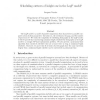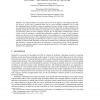1529 search results - page 33 / 306 » Energy-Based Models of P Systems |
FMSD
2000
13 years 8 months ago
2000
We review a number of formal verification techniques supported by STeP, the Stanford Temporal Prover, describing how the tool can be used to verify properties of several versions o...
DNA
2007
Springer
14 years 2 months ago
2007
Springer
In search for “realistic” bio-inspired computing models, we consider asynchronous spiking neural P systems, in the hope to get a class of computing devices with decidable prope...
IEEESCC
2008
IEEE
14 years 2 months ago
2008
IEEE
—This paper presents a novel approach to model a complex evolving system, a Digital Business Ecosystem (DBE) that takes the specific needs of Small and Medium-sized Enterprises ...
PC
2000
13 years 8 months ago
2000
The LogP model is a model of parallel computation that characterises a parallel computer system by four parameters: the latency L, the overhead o, the gap g and the number of proc...
COCOON
2005
Springer
14 years 2 months ago
2005
Springer
Abstract. The original definition of P-systems calls for rules to be applied in a maximally parallel fashion. However, in some cases a sequential model may be a more reasonable as...


